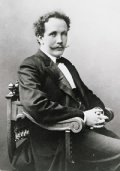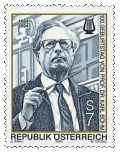
Richard Strauss
Europe in the late 1800's was a time of emotional restraint. Conversation was polite and vacuous, and sex was never mentioned.
A 24 year old Richard Strauss shocked Viennese society with his first major success in 1888, his tone poem
Don Juan. Don Juan's hero is an insatiable philanderer who is destroyed by his own desires in a storm of passion. The text was openly erotic, the music sensual, the scandal ensured Strauss's fame.
Strauss followed his success with a completely different theme - that of death. It may seem morbid to us now, but the Victorians and 19th-century Europeans were fascinated with death and mysticism. In literature (Dickens' Little Nell, Goethe's Faust), music (Schubert's
Death and the Maiden) and art, death was a popular and even revered subject.
Strauss set to work on his next tone poem entitled Tod und Verklärung ('Death and Transfiguration'). Unlike in
Don Juan which was about the reasons for the downfall of its hero; in Tod und Verklärung, Strauss explores the thoughts and feelings of a man struggling with, and finally accepting his own death.
Legend has it that Strauss wrote
Death and Transfiguration from his own experiences of a nearly fatal illness he had. Richard Specht, a contemporary of Strauss wrote:
“Death and Transfiguration was created in the year 1889 after a severe illness, an echo of the time when treacherous fever smote the young tone-poet, and in which the will to live and the dissolving of earthly shackles into eternity fought for predominance”.
In fact, Specht was simply wrong in his dates. The “
treacherous fever” he referred to occurred two years after Tod und Verklärung was completed, and a year after its triumphant first performance. Strauss himself wrote that the work was purely a product of his imagination.
But the legend stuck fast, which is in itself a testimony to the dramatic and expressive power of Strauss's music.

Karl Bohm
is based on Strauss's concept that a symphonic work can arise from a single formative poetic idea - in this case a young man, an idealist who is struck down by a terrible illness, his ambition lost and youth destroyed, portrayed by the urgency and vibrancy of the music.
The work starts out with a quiet pulsing in the strings and timpani, its irregularity representing the slowly failing heartbeat and the trobbing of the all-encompassing fever.
The fever intensifies, and the hero's life is played out before his eyes; nostalgic childhood memories, youthful desires but worst of all, he is tormented by the realisation that he has failed to fulfil his ideals. He struggles, the music becomes agitated, tormented and explosive. And he reminisces again.
Then, as Strauss himself describes, “
death seems to knock at the door”. The opening quiet rhythms are now threatening and overpowering, blaring forth on brass and the ever-present timpani.
The moment of death and transfiguration is the climax of the work: a sweeping upward glissando ending in hush, with quiet gong strokes and a pianissimo low C sustained in the depths of the orchestra. Then the transfiguration begins. An aspiring theme heard earlier rises slowly and majestically (starting on horns), leading to the grand, ultimately serene affirmation of the coda.
In Death and Transfiguration, the “
soul finds gloriously achieved in eternal space those things which could not be achieved here below”.
This set of 3 compact disc contains the complete set of Richard Stauss's tone poems, from his early success in
Don Juan through
Thus Spake Zarathustra, “Till Eulenspiegel” and
Eine Alpensinfonie (An Alpine Symphony). Karl Bohm has long been a Strauss specialist - his conducting brings out the complex richness of Strauss's orchestration. And orchestral color painting emotional complexity is what Strauss is all about.
With this set, you get childish playfulness, Romantic heroism, sexual obsession, elegant waltzes, seduction, and ultimately death and a view of heaven. Immaculately performed, and all for a bargain price.
Please support Good-Music-Guide.com
by purchasing this CD using this link.

Track Listing
Richard Strauss
Complete Tone Poems
3 CD Boxed Set
Karl Bohm
Dresden Staatskapelle
Berlin Philharmonic Orchestra
- Eine Alpensinfonie
(An Alpine Symphony) for orchestra, Op. 64
- Don Juan
tone poem for orchestra, Op. 20
- Der Rosenkavalier
Opera, Op. 59 Waltzes from Act III
- Also sprach Zarathustra
(Thus Spoke Zoroaster), tone poem for orchestra, Op. 30
- Festliches Präludium
(Festive Prelude), for organ & orchestra, Op. 61
- Till Eulenspiegels lustige Streiche
(Till Eulenspiegel's Merry Pranks), tone poem for orchestra, Op. 28
- Salome
opera, Op. 54 Dance of the Seven Veils
- Ein Heldenleben
(A Hero's Life), tone poem for orchestra, Op. 40
- Tod und Verklärung
(Death and Transfiguration), tone poem for orchestra, Op. 24